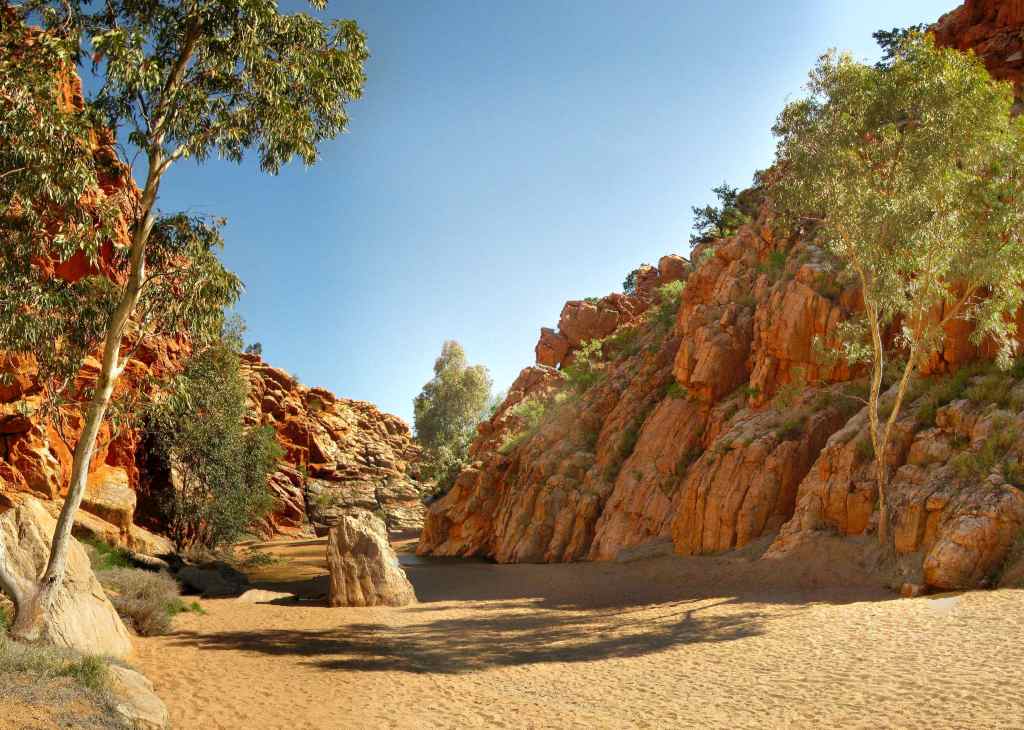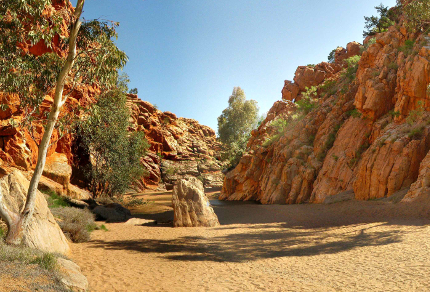
Emily Gap near Alice Springs (© Vilis Nams)
Still pimpled with red bites in less than convenient places from our Wet Tropics backpacking trip on Hinchinbrook Island, Vilis and I cast our thoughts ahead to desert country and Alice Springs. Earlier in the week, I borrowed library books with titles like Outback Australia and Discover the Northern Territory. Today, I began to peruse them in earnest and learned a great deal of useful and intriguing information. For example, let me quote some statistics on the survival of various mammals in the sun at 40°C with no water to drink. Humans –physiological wimps that we are –would last four to six hours. Livestock would fare noticeably better, with pigs lasting a day or two, cattle surviving for as long as four or five days (that’s impressive!), and sheep hanging in there for a week, give or take a day. Camels, those ships of the desert with built-in water supplies, can tolerate such conditions for in excess of fifteen days.1 When I related this information to Vilis, he said, “So, if you’re lost in the desert on a camel, don’t share your water with the camel.” Sage advice.
As every Australian and many people from elsewhere in the world know, Alice Springs is located in the geographical centre of this continent, near the bottom of the Northern Territory. The city lies on the northern flank of the MacDonnell Ranges of cliffs, gorges, and uplands within a usually arid environment supporting sparse vegetation. This makes it distinctly different from the lusher, tropical environs of The Top End, the northernmost region of the Northern Territory.2 The annual rainfall for Alice Springs is about 285 millimetres, most of which it receives during the summer Wet.3 As befits a true desert town, Alice Springs experiences blazing heat in summer (average January maximum is °36 C) and temperatures that drop below freezing in winter (average July minimum is 4°C).3 When I checked the Alice Springs weather forecast for next week, it rather surprisingly indicated rain over the weekend, followed by sun and mild temperatures that are to lift to 30° by later in the week. The temperatures are no hotter than what we’ve recently experienced in Townsville, but the rain is off-putting since it conjures up images of potential flooding and impassable roads.
Be that as it may, we are preparing to undertake that long drive halfway across this immense continent to immerse ourselves in the red heart of Australia for a few days. This means taking car repair tools with us, plenty of food, and gallons of drinking water. We plan to drive major sealed highways – Flinders, Barkly, Stuart – which have regular fuel stops, and won’t take any chances on getting stranded on the wrong side of a creek or lake that didn’t exist yesterday. That happens in the outback.
With all the rain the Alice Springs area has received since January (twice the annual average),4 the desert may be blanketed in flowers and surging with wildlife. I hope so. I compiled a list of birds having ranges which include Alice Springs and was thrilled to discover that well over half of them are species I’ve never seen. The region is also home to many reptiles and mammals I haven’t yet observed, so I’ll pack field guides to identify those particular taxonomic groups of vertebrates, too.
I went online to check out interesting things to do in the Alice Springs area, two of which caught Vilis’s and my attention. One was hot air ballooning (very expensive, as it turns out) and the other was seeing the desert from the hump of a camel (much more reasonably priced). We decided we would ride camels, explore Alice Springs Desert Park, do some hiking and birding in the East and West MacDonnell Ranges, and check out some of the city’s cultural venues. So, we’ll soon be off to Alice Springs. The weather will decide when.
References:
1. Malcolm Gordon. Outback Australia: A Guide to the Northern Territory and Kimberley, fourth edition. 2000. Little Hills Press, Seven Hills, NSW. p. 131.
2. Jocelyn Burt. Discover the Northern Territory. 1995. Tuart House, University of Western Australia Press, Nedlands, WA, pp. 8-26, 50-66.
3. Gordon, p. 137.
4. Eldersweather.com.au. Alice Springs Local Weather. © Elders Limited 1999-2009. Accessed 21-Sep-2010. http://www.eldersweather.com.au/nt/alice-springs/alice-springs?fc=9154


